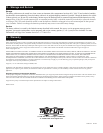
[2]
1 – Introduction
Tripp Lite’s Extended-Run 3-Phase Battery Cabinets connect to SmartOnline 3-Phase UPS Systems to provide long-lasting battery
backup for data centers, telecommunications, networks, industrial facilities, security, emergency systems and other mission-critical
applications that require high capacity, high availability and extended runtime.
Features
f Battery cabinets are available in voltages from 240 VDC through 480 VDC and capacities from 33 to 720 ampere-hours with
a constant power rating of up to 595 kW @ 15-minute rate.
f Battery cabinets contain multiple 6 or 12 VDC batteries connected in series for higher voltages or in series-parallel for higher
voltages and capacities. Multiple battery cabinets may be connected in series for increased runtime.
f Depending on the number of individual batteries contained, each battery cabinet will have 2, 3 or 4 tiers with 8, 10 or 12
individual batteries (maximum) per tier.
f The battery cabinet structure is rated up through Seismic Zone 4 applications in compliance with the Uniform Building Code.
Removable access panels facilitate periodic maintenance. There is a minimum of 6 inches of clearance above the individual
batteries for access to terminals.
f Battery cabinet frame and rails are 10 gauge steel; exterior panels are 16 gauge steel. Baked powder coat finish provides chip
and corrosion resistance.
f Battery cabinet is shipped bolted to pallet with a double layer of protective stretch wrap and integrated corner and top
protection.
f Appropriate ventilation and convection cooling of the individual batteries is provided via ½-inch spacing between batteries.
Front and rear vents allow the free flow of warmer air out of the battery cabinet.
f The internal battery series or series-parallel circuits are completely wired. The negative leg of each series string of batteries
terminates into an insulated terminal block.
f An optional molded case circuit breaker is available for over-current protection. (The molded case circuit breaker can be
fitted with a UV relay, shunt trip and auxiliary contacts as additional options.)
f User-supplied power output cables can be fed into the battery cabinet through built-in 8-inch conduit knockouts in the top or
sides of the cabinet (gland plate included). Shorting bars provide a positive landing power connection for parallel strings in a
single cabinet. All available power connection points are at the top of the cabinet, above the topmost tier of batteries.
f For improved safety, higher power density and minimized maintenance, the cabinet systems use Valve-Regulated Lead-Acid
(VRLA) recombinant batteries. The electrolyte in these batteries is immobilized in either an absorbent mat separator or a
gelling medium, eliminating the spilling hazards and maintenance requirements of free liquid electrolyte. There is no need to
add water or measure specific gravity.
f Because the batteries are recombinant cells that employ an oxygen recombination cycle, minimal gasses are emitted during
normal float charging. Each cell contains an individual valve which releases the gas products of overcharge and prevents
pressure build-up within the cell.
f Select battery cabinets (“C” models) include an integrated battery charger.


















